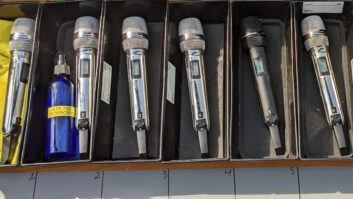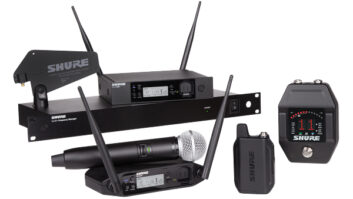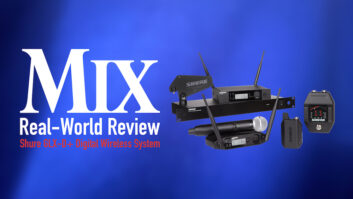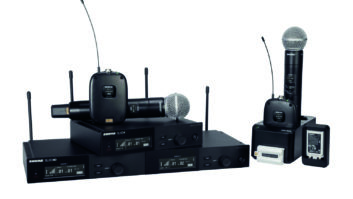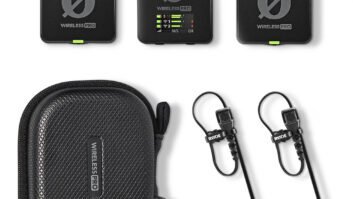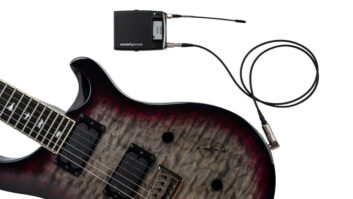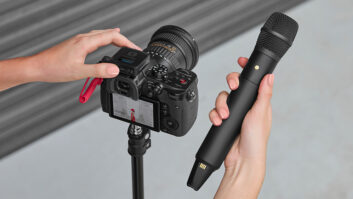Grouplove performing at Bottle Rock 2013 with Professional Wireless Systems helical antenna supplied by Delicate Productions.

From the pages of Music Festival Business:
The CMA Music Festival Fan Fair has been a country music staple since its inception in 1972. With each year’s show growing bigger than the one before, the 2013 Festival brought together more than 450 artists and celebrities, more than 200 hours of performances on 11 stages, and attracted more than 80,000 fans to the four-day event in Nashville, TN.
While some of country music’s biggest stars performed at the festival, there was plenty of activity behind the scenes that live audiences and TV viewers at home were never privy to, as audio engineers and RF/frequency coordinators orchestrated the hundreds of wireless audio units required to pull off a festival of this magnitude.
According to Jason Glass, RF coordinator with Clean Wireless Audio, he managed more than 600 frequencies of wireless microphones, in-ear monitors, intercom systems, and TV ENG crew mics, plus hundreds of frequencies of two-way radio channels, resulting in clear audio at this year’s CMA Music Festival. Clean Wireless Audio, which provides radio frequency engineering services to prevent and solve problems associated with wireless audio equipment, was contracted by Sound Image, the main sound company for the gig, to supply a dedicated RF coordinator (Glass) to work alongside the crew. Without any coordination, all this gear, arriving on-location via sound engineers, performers, local TV crews, radio stations, documentary teams shooting the festival for upcoming films, etc., would be working simultaneously and vying for space within the same, limited wireless spectrum.
Already an enormous task to pull off, here’s where this chaotic situation gets even messier. The FCC, which licenses and allocates frequencies of the spectrum to television stations, radio stations, mobile device service providers, and others, continues to sell off chunks of the spectrum (which is generating billions of dollars of revenue for the government), each time reducing the amount of space that’s available to pro audio professionals. In fact, Auction 73 gained loads of unwanted attention in 2008 when the FCC began to sell off the rights to transmit in the desirable 700 MHz frequency band. Once the final transmissions in this range were broadcast in 2009, industry professionals were left with a significantly diminished spectrum.
When you’re dealing with enormous events such as multi-stage festivals with a host of bands and hundreds of pieces of wireless equipment, the signal of every piece of gear needs to be carefully coordinated so that no two units are attempting to operate on the same frequency at the same time. Should that happen, you’ll get none of the crisp audio results you’re looking for, but will instead end up with static. This could be disastrous if, say, Carrie Underwood is trying to perform “Before He Cheats” to 40,000 fans and her mic suddenly drops out because another band, setting up on a side stage, turned on a different piece of wireless gear that’s competing with Underwood’s mic on the same frequency.
Sound companies responsible for such high-profile gigs as CMA Music Festival and others often dedicate a member of their crew or hire an outside “RF” or “Spectrum Coordinator” to go on-site ahead of time, locate what TV, radio, etc. signals are already transmitting on what frequencies and locate the available frequencies that can be used. This ensures interference-free audio performances for the live audience as well as viewers at home if the event is being recorded or broadcast live.
“We’re bound by the FCC rules to operate within a certain area of the spectrum,” explains Glass. “We are secondary users of that spectrum to broadcast television. We’re trying to put on these large productions that have the same or even larger wireless requirements than we had in the past, and making it work, with much less spectrum to work with.”
Glass said that in that same part of that small spectrum (the 500 MHz to 600 MHz range), there’s also public safety communications taking up the lower end in many major U.S. cities, so audio pros have to avoid that area of the spectrum as well.
“The large festivals and events of this nature can get pretty tricky,” said James Stoffo, who originally founded and has since sold Professional Wireless Systems (PWS), which specializes in large event frequency coordination, on-site technical services and support and high-end wireless equipment sales and rentals, and is now CTO and one of the main principals behind recently launched wireless gear manufacturer Radio Active Designs. “These types of events do seem to be the most misunderstood when it comes to RF. Generally, you are dealing with multiple bands who all want to use their own gear—kind of like a large awards show—but the difference is, on awards shows, they’re a little more structured for television broadcast where everything has to be precisely down to the minute. With a festival, a band shows up with all of its own gear, and not just one band, but maybe 10 bands, and you’re sort of restricted with what you can make work, because only so much can fit into the spectrum.”
Often times, sound engineers and RF coordinators will time-share frequencies between different pieces of gear. In other words, when one band finishes up a performance, and turns off their lead vocalist’s mic, the sound crew can use that same area of the spectrum for the next band’s lead vocal mic.
According to Jim Van Winkle, general manager, PWS, this is exactly why companies such as PWS exist. “Most audio companies specialize in audio and have an audio background, whereas Professional Wireless Systems came in from the radio frequency side and has radio expertise. A wireless microphone, although an audio device, is still a radio. At this point, we’re pushing the limits of what the manufacturers expected when they designed these wireless systems.”
“The most important thing is to adequately plan and do advance work,” adds Glass. “Part of the preparation [is to check out] the FCC databases that are available to the public that are supposed to show what’s on the air that you can avoid, such as television stations, public safety transmitters, etc. However, it has no information about all the other unlicensed users out there. So, you also need to determine what your client needs and be on top of how many microphones will be used, how many in-ear monitors, what equipment from which manufacturers will be used, what are the model numbers, the frequencies they can operate on, etc. Once you determine that, then it’s very important to try and get an advance site survey where you actually go to the venue with a scanner or a spectrum analyzer that you can measure the radio frequency spectrum at that location. Then you use that information as a beginning platform for when you walk into the venue and you turn on your gear.”
Chris West, sound engineer for SE Systems says, “As sound engineers, you never want your artists [or the audience] to know that there’s any kind of problem. We want them to think that we can do this job because that’s what they hire us to do. So you definitely want to try to work all that out before the performer gets out there and before something happens, like their in-ears take a drop. That’s where the real concern is for me when artists are relying on their wireless frequency being clean and it gets stepped on and they’re not able to perform at their best.”
To add to these challenges, Van Winkle sees some additional problems on the horizon. “In 2014, we’ll see the introduction of portable and fixed white space devices,” he says. “The smart phones and white space portable devices will hit the market and they will all operate on the same radio spectrum as the majority of the wireless microphones and intercoms in the U.S., so our available spectrum will be reduced even further. It was reduced by 35 percent with the 700 MHz auction, and next year, it will be reduced even more. Yet, more and more equipment is expected to operate in less and less space, based on the demands of the shows.”
“It already started on some level,” adds Stoffo. “What’s going to happen is, for the first time in the history of radio, we’re going to have these consumer digital products transmitting in the same band as wireless microphones and intercoms. This is going to not only affect festivals, but also churches, television, film production, theater, sporting events, you name it.”
For now, a number of companies, such as Shure, Sennheiser, Kaltman and others, offer industry pros ways around the current spectrum congestion.
“A music festival is a pretty good example of something that is already naturally a bit chaotic,” says Nick Wood, product marketing manager at Shure. “You have many bands, many stages and white space devices that could certainly contribute to that chaos. I think the general answer for that challenge is that there’s not one silver-bullet solution. The best approach is to have a suite of tools that help you plan for events in advance and organize as much of that confusion ahead of time. Then, you need to keep in mind that there will always be surprises that will pop up. When there’s a show later that day, your time to make adjustments is very limited, so to have tools for planning before an event, and tools for identifying and responding to a problem as quickly as possible during the event, is really the best way to go.”
Wood points to a number of tools from Shure that allow industry pros to make changes “dynamically.” For instance, “our Axient Wireless Management Network detects interference and can actually switch frequencies during a show to avoid it.”
The Axient Spectrum Manager tool is designed to scan the UHF spectrum and coordinate compatible frequencies for any number of wireless channels, as well as continuously monitor, rank and deploy backup frequencies when needed. Additionally, the company’s Wireless Workbench 6 is event planning and control software that was developed concurrently with the Axient platform.
“The essence of Wireless Workbench is that it’s a comprehensive monitor and control interface, so it’ll give you one view, all together in one place, of all of your microphone and in-ear monitor channels on a network,” explains Wood. “Also, you can calculate frequencies for a number of different equipment types, including those of other manufacturers. Just from an efficiency standpoint, having that consolidated into one workspace is really great.”
Sennheiser, too, has its own solutions that address the wireless spectrum challenges. Its newest offering is the Digital 9000 System, a digital wireless system that can reportedly transmit completely uncompressed audio, artifact-free. The system includes the EM 9046 receiver, SKM 9000 handheld and SK 9000 body pack transmitters, and a suite of accessories.
“This is our first professional digital wireless system,” says David Missall, Sr. technical services engineer, Sennheiser Electronic Corporation. “It’s a complicated, full digital modulation scheme of uncompressed, digital audio at 24-bit, 96 kHz rate, with highly linear components and a Lithium ion rechargeable battery to power the transmitter. By doing that, by putting in components with high linearity, we have a system that does not create intermodulation.”
Missall continues, “Intermodulation can happen when two or more transmitters come in close proximity to one another. The RF signal of one transmitter can overload the internal components of the other transmitter and create new frequencies. Usually that is a very difficult problem in any multichannel situation. Because we were able to put in more linear components that will not be overdriven by RF interference, we don’t have to worry about intermodulation.”
Several sound engineers and RF coordinators agree with Glass’ earlier assessment that a spectrum analyzer is another essential tool when working large-scale music festivals.
There are certainly a variety of spectrum analyzers on the market today, which range in price and ability and also from hardware to all software options. Kaltman Creations, which offers portable RF and EMC spectrum analyzers and antennas, as well as RF shielding, was built by a core team with pro audio backgrounds. President Mark Kaltman says he started his company with a unique handheld, motorized cable coiler, but quickly identified that the FCC allocations were going to be a serious issue for the pro audio industry.
“That’s when I started looking around for affordable spectrum analyzers that could be sold to the pro audio segment,” Kaltman said. “I partnered with a company called Aaronia AG of Germany, and we started selling Aaronia analyzers into the pro audio world. One thing led to another, and I saw no end to the problems related to wireless interference and frequency coordination for pro audio. The FCC continued to reallocate and sell off the spectrum, and the amount of spectrum that was available for pro audio professionals continued to shrink. At the same time, wireless use was, and still is, growing at an exponential rate. And so, we offer true spectrum analyzers that specifically address the needs of the pro audio market.”
One of the company’s RF spectrum analyzers, the RF Command Center, sets-up, monitors and manages wireless microphones, in-ear monitors, intercoms, remote control systems, security, access control, etc. at live events.
According to Kaltman, “we have something called a ‘UFO alert,’ which stands for ‘unidentified frequency object.’ Essentially, it’s a rogue interference alert. So, as the audio tech or RF tech is doing a show or setting up equipment, if someone were to turn on a transmitter that the engineer wasn’t expecting, that he hadn’t accounted for, it will start flashing at him on the screen. So it warns you that somebody turned on a transmitter that’s not one of yours.”
And while the RF Command is something you would set up at the monitor mix/front of house position, the company also offers a portable, tablet-based solution with its RF-Vue. It’s available in several versions, but the flagship model is the RF-Vue T10, which is integrated into a 10-inch touch tablet with full Windows 8 operating system. The T10 covers the standard wireless microphone and IEM frequency range of 470 MHz to 700 MHz (additional models are available offering greater frequency ranges). “You can also use it with your own tablet,” adds Kaltman. “So, you can walk around the venue. It doesn’t have all the same features as the Command Center, but it allows you to visually see the RF spectrum.”
However, even with the many options currently available, Kaltman, as well as a number of other industry professionals, seem to share the same sentiment: “A lot of the wireless equipment manufacturers are struggling to find ways to squeeze more transmitters than ever into a decreasing spectrum,” he says. “I’m a little fearful that it might be a losing battle because the FCC seems to have little or no regard at all for what’s going on with wireless microphones. From a lobbying standpoint in Washington, we’re a very small entity and I’m afraid we have very little power as far as us having our voices heard, and trying to maintain the spectrum. Especially when you’re looking at such huge dollars when the FCC sells off spectrum. It’s hard to combat that. The wireless manufacturers are struggling to come up with new technology. From our standpoint, we believe a strong solution is to see what’s going on in the RF spectrum with an analyzer and identify where the problems are.”
“First off, the spectrum is going to continue to get eaten up badly,” agrees West. “These new devices that are coming around are going to drive the entertainment industry to make better products. They are going to force the manufacturers to come up with better ways to deal with this problem. Manufacturers are going to have to spend the money on R&D to create devices that will address this situation. When it comes down to it, we can’t have concerts, political events, corporate events, sporting events, where we have the main microphone going down.”
“As manufacturers, we really do have to think outside the box in terms of design,” says Missall. “We can’t stick with the same old way; we have to continually look at new ways to innovate and new ways to do the same thing. In order to do that, we have to have information, maintain our customer visits, get feedback from them, do research, and invent new technologies ourselves and try and create a new path. And we always have to keep track of FCC regulations. Also, we’ve been talking about the UHF frequency range, which is very popular because of its great wave propagation and the perfect area for broadcasters and wireless gear to operate in. But, we have to look outside the UHF range and see if there’s anything viable in other frequency ranges. As long as we don’t lose quality and we can still do multiple channels, we have to look at all possibilities.”
According to Van Winkle, Radio Active Designs is one company that’s addressing the heart of the issue. “Everyone else continues to manufacture new equipment in the same UHF spectrum using the same wide band FM or digital technology, so it does not relieve any of the spectral congestion which is going to be the primary problem next year,” he says. “RAD has come out with some technology that relieves that spectral congestion in the UHF band to make more room for microphones by pulling all of the intercoms out of the UHF band and using a narrow band technology instead of FM or digital which is about 25 times more spectrally efficient.”
“We started to introduce this concept of moving back to VHF, and I think you’re going to start to see the other manufacturers redesigning their products in VHF as well,” says Stoffo, who along with his three partners and industry veterans (Jamie Schnakensberg, Mark Gubser and Henry Cohen) introduced the brand-new company, as well as its first product the UV-1G Wireless Intercom System, at NAB 2013 earlier this year. “We brought back this retro idea of VHF,” he says. “Every one of the manufacturers out there came by our booth during the show and were very interested to know that you can go back to VHF. It’s just that, somebody had to be the first one to do it.”
The UV-1G, which Stoffo expects to ship by end of this year or early 2014, is an Enhanced Narrow Band wireless intercom system that offers RF channels possessing an occupied bandwidth of 25 kHz with the audio characteristics one would expect from a traditional FM system. The UV-1G also utilizes the relatively unused VHF range for all belt-pack portable devices. This leaves more room for operation of other wireless devices, such as in-ear monitors and wireless microphones.
“When I coordinate an event like NBA All-Stars, there might be 500 wireless mics and intercoms on that court at one time, but less than 10 of them are VHF,” explains Stoffo. “In fact, I checked with the RF coordinators at the Superbowl and they said that out of all the thousands of wireless systems at the game, only about two percent of them are VHF. So, VHF is wide open down there. It’s like a clean slate.”
Stoffo continues that the reason why “we really came up with the company, not because we wanted to become manufacturers or change careers, but it was out of our own necessity and for our own livelihoods. If someone didn’t come in here and design something out of the UHF band, we’d all be out of work next year.”
With 2014 coming up quickly, and some of the white space devices already available, manufacturers are quickly going to need to address these issues.
“This period we’re in right now, this five-year period between say 2009/2010 and 2014,” said Stoffo, “it represents greater changes to the wireless spectrum than any other five-year span in radio, on earth. And people are barely hanging on now. Once they start with all these white space devices, the RF coordination of large events will separate the men from the boys.”
